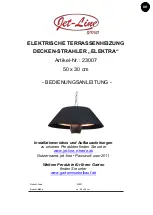
Page 13
INSTALLATION
INSTALLATION
d) It is preferable for the discharge to be visible at both the tundish and the final point
of discharge but where this is not possible or practically difficult there should be
clear visibility at one or other of these locations. Examples of acceptable discharge
arrangements are:
1. Ideally below the fixed grating and above the water seal in a trapped gulley.
2. Downward discharges at a low level; i.e. up to 100mm above external surfaces
such as car parks, hard standings, grassed areas etc are acceptable providing
that where children play or otherwise come into contact with discharges, a
wire cage or similar guard is positioned to prevent contact whilst maintaining
visibility.
3. Discharges at a high level; e.g. into metal hopper and metal down pipe with the
end of the discharge pipe clearly visible (tundish visible or not) or onto a roof
capable of withstanding high temperature discharges of water and 3m from
any plastic guttering systems that would collect such discharges.
4. Where a single pipe serves a number of discharges, such as in blocks of flats,
the number served should be limited to not more than 6 systems so that any
installation can be traced reasonably easily. The single common discharge pipe
should be at least one pipe size larger than the largest individual discharge pipe
to be connected. If unvented hot water storage systems are installed where
discharges form safety devices may not be apparent i.e. in dwellings occupied by
blind, infirm or disabled people, consideration should be given to the installation
of an electronically operated device to warn when discharge takes place.
Safety
The safety devices supplied or fitted on an Aquarea are selected for their suitability
for the temperatures and pressures involved. They must not be changed, removed or
by-passed and it is essential that only genuine replacement parts supplied or approved
by Aquarea are used. This includes the immersion heaters, which must incorporate an
energy cut-out. All parts are available to approved installers from Aquarea.
Combination Inlet Group
Combines elements 1, 2 and 3 below.
1.
Pressure Reducing Valve
- This must be fixed near the cylinder. The cold water supply
to any mixer taps/showers must be taken from the cold water tapping of this valve
to ensure balanced hot and cold pressures. This valve is factory set to ensure the
correct operating pressure for the Aquarea.
2.
Non Return Valve
- This is integral with the pressure reducing valve to prevent
backflow of hot water towards cold water draw off points.
3.
Cold Water Expansion Relief Valve
- This safety device is preset at the factory and
will relieve excess cold water pressure resulting from a fault condition.
Line Strainer
This is integral within the combination inlet group to reduce the likelihood of
contaminants fouling the valve seat. Following installation this line strainer must be
cleaned and replaced. This needs to be carried out on a regular basis. as part of the
annual maintenance/service check.
Tundish
This is to allow the discharge from any Relief Valve to be seen. It must be fitted away
from any electrical devices. See page 15 for discharge pipework details.














































